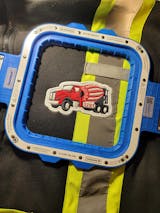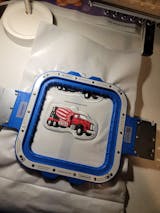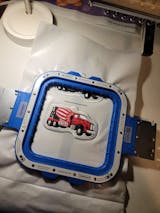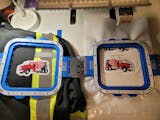1. Introduction to New Brothread Color Resources
Navigating the world of embroidery threads can feel like standing before a wall of rainbows—beautiful, but overwhelming. That’s where New Brothread steps in, offering a structured approach to color management that brings clarity to the chaos. As a leading name in embroidery thread standardization, New Brothread provides essential resources for color matching, brand conversions, and project planning, whether you are using a home embroidery machines or a commercial one. Whether you’re a seasoned professional or just threading your first needle, this guide will help you unlock the full potential of New Brothread’s color charts. We’ll spotlight the dual Brother and Janome color systems, explain why official resources matter, and set the stage for seamless, stress-free embroidery planning. Ready to turn confusion into creative confidence? Let’s dive in.
Table of Contents
- 1. Introduction to New Brothread Color Resources
- 2. New Brothread Color Charts: Visual Reference Guides
- 3. Cross-Brand Conversion Charts for Seamless Substitutions
- 4. Accessing Printable Charts for Offline Planning
- 5. Comparing New Brothread Color Sets: Value & Variety
- 6. Practical Guide: Using Charts in Machine Embroidery
- 7. Identifying Official Sources & Avoiding Inaccuracies
- 8. Step-by-Step Chart Interpretation for Beginners
- 9. Conclusion & Next Steps
- 10. FAQ: New Brothread Color Charts
2. New Brothread Color Charts: Visual Reference Guides
Selecting the perfect thread shade shouldn’t be a guessing game. New Brothread’s color charts are designed as visual roadmaps, guiding embroiderers through a spectrum of possibilities with precision and ease. Let’s explore how these resources empower your creative process.
2.1 Official Downloadable Color Charts
New Brothread makes it easy to access a wide range of color charts, each tailored to different machine ecosystems and creative needs. Through their official website, you’ll find downloadable charts for:
- 40 Brother Colors
- 63 Brother Colors
- 80 Janome Colors
- Variegated Color Collections
Each chart is more than a static list—it’s a visual reference, complete with swatches and numbering systems that help you identify, select, and match specific shades. The dual assortment system is key: colors without the “N” prefix are part of the Brother-compatible collection, while “N” indicates Janome compatibility. This distinction ensures you’re always working with the right palette for your machine and project.
What’s more, these charts aren’t just digital. When you purchase a physical thread kit—like the popular 80-pack featured in user reviews and YouTube demonstrations—you’ll often find a printed color chart included right in the box. Many users highlight the convenience of having both the threads and the chart on hand, making it easier to plan, substitute, and experiment with colors on the fly.
Whether you’re starting out with a basic set or investing in the expansive 150-color Mega Kit, these charts are your backstage pass to organized, frustration-free embroidery.
2.2 Numbering Systems & Organization
The logic behind New Brothread’s numbering system is all about cross-brand compatibility and user clarity. For example, the 150-color Mega Kit is strategically curated to include a broad mix of shades that align with both Brother and Janome standards. This means you’re not just getting variety—you’re getting versatility.
- Brother-Compatible Colors: These are typically identified by numeric codes (e.g., 001 for white), making it easy to cross-reference with Brother’s original thread charts.
- Janome-Compatible Colors: Look for the “N” prefix—these threads are mapped to Janome’s palette, ensuring seamless integration with Janome machines and designs.
New Brothread also provides technical details for each thread type. Their standard 40WT polyester threads come in 1000M (1100Y) spools, ideal for both home and commercial use. For fine detailing, the 60WT Matt Embroidery Thread Kit introduces 50 new country colors, complete with charts that help you find similar Brother color numbers and names.
Thread specs go beyond just color. The 60WT Matt threads, for instance, feature a frosted matte finish for a sophisticated look and enhanced fade resistance—perfect for projects exposed to sunlight. Each spool is designed with a locking base to prevent tangling, and technical recommendations (like needle size and stitch density) are provided to help you achieve optimal results.
In short, New Brothread’s charts and numbering systems are more than organizational tools—they’re your secret weapon for achieving color accuracy and professional-grade results, no matter which machine or project you tackle next.
3. Cross-Brand Conversion Charts for Seamless Substitutions
Ever found the perfect embroidery design, only to realize the listed thread colors don’t match what’s in your stash? New Brothread’s conversion charts are here to bridge that gap, making brand-to-brand substitutions a breeze and keeping your creative momentum going.
3.1 Brother/Janome Conversion Systems
New Brothread’s dual-path conversion system is designed for flexibility. If you’re working with Brother-compatible threads, you can use official conversion charts to find matches in the Madeira color range. For Janome-compatible threads (those “N” numbers), conversion extends to Robison-Anton colors. This opens up a world of possibilities, especially if you’re juggling multiple machines or collaborating with others who use different brands.
Accessing these conversion resources is straightforward:
- Brother Conversions: Downloadable charts are readily available through New Brothread’s official channels, covering 40 and 63 Brother color sets.
- Janome Conversions: For the latest Janome-to-Brother conversion tables, simply email sales@embsewsupplies.com. This direct approach ensures you receive up-to-date, accurate information—no more hunting for outdated PDFs or second-guessing your substitutions.
The result? You can confidently swap threads between brands, knowing your finished project will look just as intended.
3.2 Third-Party Conversion Tools & Limitations
While official charts are the gold standard, third-party platforms like Simthread and Embroidery Library offer additional conversion tools that expand your options. Simthread, for example, provides charts covering multiple brands and configurations, including Madeira Polyneon and Rayon. Embroidery Library’s online Thread Exchange lets you cross-reference thread numbers in real time, making it easy to find close matches across brands like Isacord, Floriani, and ThreadArt.
However, it’s important to approach these tools with a critical eye. Material differences (such as polyester vs. rayon) and dye-lot variations can affect color accuracy, even when the numbers line up. Some charts may list “xxx” for colors without direct equivalents, signaling that a perfect match simply doesn’t exist. For specialty shades or unique finishes, physical testing on fabric is always your best bet.
A practical example: ThreadArt maintains its own conversion table with Brother colors, creating an indirect pathway for New Brothread compatibility. But remember, not every shade will have a one-to-one match, and results can vary based on thread composition and manufacturer.
The bottom line? Use a multi-resource approach—combine digital charts, physical color cards, and real-world stitch tests—to ensure your substitutions are as seamless and vibrant as your original vision.
4. Accessing Printable Charts for Offline Planning
In the vibrant world of machine embroidery, having reliable, accurate color references at your fingertips can be the difference between a project that pops and one that falls flat. Whether you’re prepping for a marathon stitching session or planning the perfect palette for your next masterpiece, printable color charts are your secret weapon for offline success.
4.1 Digital Resources on Official Channels
New Brothread has made it remarkably easy to access a suite of downloadable color charts tailored for every embroidery scenario. Through their official website, you’ll find a comprehensive library of resources, including:
- 40 Spools Brother Color Card and Conversion Chart
- 63 Spools Brother Color Card and Conversion Chart
- 80 Spools Janome Color Card
- Specialized Charts: 50 Colors of Variegated Color Card and 20 Colors of Metallic Color Card
These charts are thoughtfully organized by assortment—Brother-compatible colors (numeric codes) and Janome-compatible colors (N-prefix)—so you always know which palette matches your machine and design requirements. Each chart provides not only swatches and color numbers, but also technical details like thread weight (500M, 1000M, and even 5000M spools), making project planning and material estimation a breeze.
For those who crave customization, commercial platforms such as Etsy offer editable Canva templates, allowing embroidery businesses to tailor charts to their actual inventory or branding needs. But for the most reliable and up-to-date information, the official New Brothread website remains the gold standard.
Pro Tip: When using these charts for color matching, always verify shades under natural light. Digital screens and artificial lighting can distort color perception, so a printed chart viewed in daylight gives you the truest match—your stitches will thank you!
4.2 Physical vs. Digital Color Accuracy
Let’s face it: no matter how advanced your device, there’s a world of difference between what you see on a screen and the thread that comes off your spool. Digital color charts are convenient for quick reference, but physical, printed charts are essential for true-to-life color matching.
Why the difference? Screens display colors using light, which can shift hues and brightness. Threads, on the other hand, reflect light differently depending on material, dye lot, and ambient conditions. That’s why seasoned embroiderers rely on printed charts for final decisions—especially when color accuracy is mission-critical.
Best Practices:
- Print your color charts on high-quality paper and view them in natural daylight.
- Replace your printed color cards every 2–3 years to account for fading and evolving thread lines.
- Use printed charts alongside physical thread samples for the most precise results.
By combining digital convenience with the tactile reliability of printed references, you’ll always stitch with confidence—no color surprises, just beautiful, consistent results.
5. Comparing New Brothread Color Sets: Value & Variety
Choosing the right thread set can feel like picking a box of crayons for grown-ups—do you go for the essentials, or splurge on the full rainbow? Let’s break down the options so you can invest smartly and stitch boldly.
5.1 Brother vs. Janome Assortment Options
New Brothread operates with two main color assortment systems, each designed for seamless compatibility:
- Brother Assortments: These sets (40, 42, 50, 63, and 64 spools) feature numeric codes and are tailored for Brother machines and designs. The 40-spool set covers foundational shades, while the 63-spool set expands your palette with additional complementary colors—without crossing into Janome’s territory.
- Janome Assortments: Here, you’ll find the “N” prefix, marking threads that align with Janome and Robison-Anton color standards. The 80-spool Janome set is the most extensive single-assortment offering, available in both 500M and 1000M spools, and is perfect for users who want comprehensive coverage of the Janome color spectrum.
- Mega Kit (150 Colors): For those who refuse to compromise, the 150-color Mega Kit blends both Brother and Janome assortments. This dual-system approach means you’ll have maximum flexibility for cross-brand matching and creative exploration.
Material Note: While most sets feature 40WT polyester threads (ideal for durability and colorfastness), New Brothread also offers 24-color mercerized cotton packs (30WT), perfect for natural fabrics like cotton or linen. These cotton threads are gassed and mercerized for a smooth, low-lint finish—just remember to use a larger needle and slower speed for best results.
5.2 Investment Analysis by Pack Size
Not sure which set matches your ambitions (and budget)? Here’s how the main options stack up:
| Pack Size | Ideal For | Features |
|---|---|---|
| 40-Spool Brother | Beginners, core projects | Essential colors, cost-effective entry, covers most basic embroidery needs |
| 63-Spool Brother | Intermediate users | Includes all 40 colors plus extras, efficient upgrade path, matches many digital palettes |
| 80-Spool Janome | Janome-focused, advanced | Largest Janome-compatible set, wide spectrum for specialty projects |
| 150-Color Mega Kit | Pros, maximalists | Both Brother & Janome colors, ultimate variety and flexibility, higher initial investment |
| 24-Color Cotton | Quilters, natural fabrics | 100% mercerized cotton, ideal for cotton/linen, smooth finish, less stretch than polyester |
User Insights:
- Many users start with the 40-spool set and quickly upgrade to the 63 or 80-pack as their creative needs grow.
- The 80-pack is praised for its wide range of shades in each color family, making it a favorite for ambitious projects.
- The Mega Kit is a powerhouse for those juggling multiple machines or commercial orders, offering unmatched versatility.
Pro Tip: Start with a set that matches your most-used machine and projects, then expand as your skills and ambitions grow. Each upgrade path is designed to build on your investment—no wasted colors, just more creative freedom.
6. Practical Guide: Using Charts in Machine Embroidery
Color charts aren’t just pretty to look at—they’re powerful tools for workflow optimization, accurate thread substitution, and flawless garment embroidery. Here’s how to make them work for you, from software to stitch-out.
6.1 Chart Interpretation & Software Integration
Modern embroidery software, like Brother’s PE Design and Embrilliance, makes integrating New Brothread color charts a breeze:
- Reading Codes: Import your design file, then select the appropriate thread palette using New Brothread’s numeric or N-prefix codes. Assign each design element its corresponding thread number for precise color placement.
- Color Change Sheets: Embrilliance allows you to print color change sheets, which detail the thread order for multi-needle machines—saving you time and reducing errors during setup.
- Workflow Optimization: Keep a digital or physical log of successful color matches and machine settings. This habit streamlines future projects and helps you troubleshoot any issues quickly.
By syncing your digital workflow with your physical thread inventory, you ensure every stitch lands exactly where—and how—you want it.
6.2 Thread Substitution Techniques
Need to swap a color on the fly? Here’s how to do it like a pro:
- Visual/Manual Matching: Compare your physical thread samples under natural light to the printed chart. For general designs, close visual matches often suffice. For photo-realistic or character embroidery, precision is key—use conversion charts and software tools for the closest possible match.
- Specialty Threads: Metallic threads require topstitch needles (80/12 or 90/14) and slower machine speeds to prevent stripping. Variegated threads benefit from careful organization—two-sided thread organizers keep them tangle-free and easy to access.
- Stitch Testing: Always test substitutions on a fabric scrap before committing to your final piece. This step reveals how the thread interacts with your fabric and design, ensuring no surprises mid-project.
6.3 Optimizing Garment Embroidery Projects
Fabric prep can make or break your embroidery results—especially on garments. Using Sewtalent magnetic embroidery hoop frames for garment embroidery offers a game-changing advantage:
- Tension Stability: The magnetic hooping system provides even, secure tension across your fabric, minimizing distortion and misalignment.
- Time Savings: Compared to traditional screw hoops, Sewtalent magnetic hoops can save up to 90% of your hooping time—transforming a tedious process into a quick, repeatable step.
- Reduced Misalignment: The firm, uniform grip helps prevent shifting, so your designs stay exactly where you want them.
- Industrial Compatibility: Sewtalent hoops work seamlessly with a wide range of industrial embroidery machines, making them a smart investment for both home studios and commercial shops.
Ready to take your embroidery workflow to the next level? Incorporating these practical techniques—and the right tools—will help you stitch smarter, not harder, and achieve professional-grade results every time.
7. Identifying Official Sources & Avoiding Inaccuracies
When it comes to embroidery, color accuracy is everything. Imagine spending hours perfecting a design, only to have the final result look “off” because of a mismatched thread. That’s why knowing where to find official New Brothread color charts—and how to steer clear of unreliable third-party sources—is a game-changer for any embroidery enthusiast.
7.1 Verified Platforms & Resources
The gold standard for New Brothread color information is their official website: newbrothread-official.com. This is where you’ll find the most up-to-date, manufacturer-approved color charts and conversion guides for both Brother and Janome systems. The site offers downloadable color cards for every major collection: 40/63 Brother colors, 80 Janome colors, specialty variegated sets, and more. Each chart is meticulously curated to ensure that what you see is what you’ll get—no guesswork, no surprises.
Why does this matter? Because third-party sources, especially those integrated into embroidery software like InkStitch, often fall short. For example, the InkStitch “Brothread 80” palette only covers the “N” prefix Janome colors, while its “Brothread 40” palette is incomplete and misses many shades from the official collection. These gaps can lead to workflow headaches, mismatched colors, and wasted materials.
Conversion charts found on platforms like Embroidery Library or ThreadArt may offer helpful cross-brand references, but they aren’t officially endorsed and can introduce errors—especially with specialty threads or new color releases. Many experienced embroiderers even keep personal spreadsheets to track accurate color codes, simply because unofficial sources can’t keep up with the evolving New Brothread lineup.
So, what’s the bottom line? Always start with newbrothread-official.com for your color charts and conversion needs. Use third-party tools cautiously, and double-check any software-integrated palettes against the official documentation to avoid costly mistakes.
7.2 Color Management Best Practices
Let’s talk about how to keep your color game strong. Even with the best digital resources, nothing beats the reliability of a physical color card from New Brothread. Digital screens can mislead you—colors shift with brightness, calibration, and even your mood lighting. Printed charts, viewed under natural daylight, give you the most accurate sense of how a thread will look in your finished piece.
For serious color management, combine your physical cards with digital tools. Use the official website for downloads and updates, but always verify your choices in person before a big project. Replace your physical color cards every 2–3 years, or sooner if you notice fading.
And when you’re testing colors on fabric, maintaining fabric integrity is crucial. That’s where Sewtalent magnetic hoops come in. Their even tension and secure grip keep your test swatches perfectly flat, so you can accurately judge how each color will stitch out—no puckering, no distortion, just pure color accuracy. This is especially valuable when you’re color-matching or experimenting with new thread combinations.
In summary: trust the official sources, keep your physical references fresh, and use tools like Sewtalent magnetic hoops to ensure your color tests are as precise as your creative vision.
8. Step-by-Step Chart Interpretation for Beginners
Getting started with New Brothread color charts can feel like deciphering a secret code—but once you know the basics, it’s surprisingly straightforward. Let’s break it down, step by step, so you can confidently match any design to the perfect thread.
8.1 Decoding Color Numbers & Systems
First things first: understand the numbering. New Brothread’s system is designed for compatibility and clarity:
- Numeric Codes (e.g., 001 = white): These are Brother-compatible colors. If you’ve used Brother threads before, you’ll feel right at home—codes like “001” for white, “800” for red, and “900” for black are standard.
- N-Prefix Codes (e.g., N204): These represent Janome-compatible colors. The “N” indicates a different palette, so “N204” is not the same as “204”—each is a unique shade.
When you open a New Brothread color chart, you’ll see each color listed with its code, name, and usually a visual swatch. If your embroidery design specifies certain thread numbers, simply cross-reference those with the chart. For Brother-based designs, match the numeric codes; for Janome, look for the “N” prefix.
If you’re working with a design that lists colors from another brand, use the official conversion charts from New Brothread’s website. These guides make it easy to find the closest match within your thread stash, keeping your projects consistent and vibrant.
8.2 Physical Matching Workflows
Now, let’s talk about the hands-on part—matching colors in real life. Here’s a beginner-friendly workflow:
- Use Natural Light: Always compare threads and charts in natural daylight. Artificial lighting can skew your perception, making blues look purple or reds look orange.
- Maintain a Personal Reference Log: Keep a notebook or digital file where you record successful color matches, project notes, and any substitutions you’ve made. This becomes a valuable resource for future projects and troubleshooting.
- Organize Your Threads: Storage matters! Many embroiderers use clear, multi-layered containers (like the four-layer stackable boxes mentioned in user reviews) to keep threads visible and accessible. New Brothread even offers two-sided organizers designed for quick color planning and easy access.
- Test Before You Stitch: When in doubt, stitch a small sample on your intended fabric. This is the ultimate test—how the thread looks on the spool isn’t always how it will look in your design.
By following these steps, you’ll build confidence in your color choices and develop a workflow that’s both efficient and accurate. Remember: practice makes perfect, and every project is an opportunity to refine your skills.
9. Conclusion & Next Steps
Mastering New Brothread color charts is your ticket to embroidery success—no more second-guessing, no more mismatched designs. Start by sourcing your charts and conversion guides directly from newbrothread-official.com to ensure accuracy. Embrace best practices: maintain up-to-date physical cards, use digital resources for planning, and always test your colors on fabric before diving into your project.
Whether you’re just starting out or looking to expand your thread collection, choosing the right set—be it a 40-spool starter or the expansive 80-pack—will set you up for creative freedom. Keep experimenting, keep learning, and let your stitches shine with confidence.
10. FAQ: New Brothread Color Charts
10.1 Q: How can I access official New Brothread color charts and conversion guides?
A: Official New Brothread color charts—including Brother and Janome assortments—are available for download on newbrothread-official.com. For the most up-to-date conversion guides (such as Janome-to-Brother or Robison-Anton), you can contact their team directly by emailing sales@embsewsupplies.com. This ensures you receive accurate, manufacturer-approved resources for your embroidery planning.
10.2 Q: Is there a free shipping option when ordering New Brothread threads or charts?
A: Yes! If you purchase over 10 spools of 1000M or 5000M embroidery thread (same size spools) for delivery within the United States, you’ll enjoy free shipping. This is a great way to stock up on colors and get your charts delivered at no extra cost.
10.3 Q: What should I know about bobbin compatibility for New Brothread products?
A: Bobbin compatibility is all about size. Size A bobbins (height: 11.4mm/0.448") are used by most sewing and embroidery machines, including many Brother, Babylock, and Janome models. Size L bobbins (height: 8.9mm/0.315") are common in commercial and home embroidery machines. Both have the same diameter, but Size A is slightly taller. Always check your machine’s manual to confirm which bobbin type is required for optimal results.
10.4 Q: How do I request a specific color conversion chart or card?
A: Simply reach out to New Brothread’s support team at sales@embsewsupplies.com and specify which chart or conversion guide you need (e.g., Brother-to-Madeira, Janome-to-Robison-Anton). They’ll provide the latest version directly, so you can match threads with confidence.
10.5 Q: What’s the best way to ensure color accuracy when using digital or printed charts?
A: For the most reliable results, always verify thread colors under natural daylight—both digital screens and artificial lighting can alter your perception of a shade. If you rely on printed charts, consider replacing them every 2–3 years to account for fading and thread line updates. Combining digital downloads with physical references ensures your embroidery colors stay vibrant and true to your vision.
10.6 Q: Where can I find additional support or community tips for using New Brothread charts?
A: New Brothread offers a vibrant community on Facebook and regular video tutorials on YouTube, where beginners and seasoned embroiderers share tips, project ideas, and troubleshooting advice. These platforms are excellent for learning how others use color charts, organize their thread collections, and manage substitutions for flawless results.
10.7 Q: Are there any special tips for beginners starting with New Brothread color charts?
A: Absolutely! Start by familiarizing yourself with the numbering systems—numeric codes for Brother-compatible threads and “N” prefixes for Janome. Use official charts for cross-referencing, and keep a personal log of your favorite matches and substitutions. Organizing your threads in clear containers can make planning and color selection much easier, especially as your collection grows.







